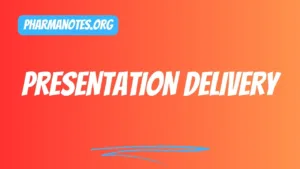Presentation delivery

Objective
At the end of this session, students will be able to:
• Identify the nuances involved in the delivery of presentation
• Practise the steps involved in creating and delivering an effective presentation
• Demonstrate appropriate body language while making presentation
Presentation
In a presentation, “Tell them what you are going to tell them; tell them; tell them what you have told them“.
A presentation is the process of presenting a topic to an audience.
It is typically a demonstration, introduction, lecture, or speech meant to inform, persuade, or build good will.
The presentation needs to be simple, with tight organization.
Steps to Deliver a Presentation
Introduce yourself & your topic
Give them a good reason for listening
Trail the themes
Develop the theme
Summarize
Respond to questions
Following stages of presentation need attention.
• Introduce yourself and the topic- Present with the main theme, tone and style of your presentation. Generally, the shorter, the simpler, the better
• Give them a good reason for listening- Remind the audience why the subject is important and relevant while explaining why they should listen
• Trail the themes- Give a preview (a road map) of the journey that is about to unfold before them. Inform them about the question handling session as well
• Develop the theme- Once the map has been shared with the audience, stick to the promised route. Present the points clearly, recapitulating on each as you progress along the route and relating one to the next by making links
• Summarize- Round up by highlighting the main ideas once more and reiterating key propositions. Remind the audience why the subject is important and relevant and remind them of any action you are expecting them to take. Let the audience know, by the force of your delivery, that you have arrived together
• Respond to questions- Invite questions and listen, and read between the lines. Let them know when it must stop. “We’ve probably got another five minutes”
Nuances of Presentation Delivery
Body Language and Appearance
• Dress comfortably for the occasion
• Be well groomed
• Appear confident in your attire
• Confident appearance will be an added advantage
• Keep the energy level high
• Avoid postures and movements such as putting both the hands in pockets, playing with coins and touching hair or moustache
• Be relaxed and keep a smiling face
• Maintain eye contact
• Make small steps around the audience with due attention to proxemics
• Vocal preparation- Speak well to create an impression
• Presentations turn monotonous for the following reasons:
Lack of variations in pitch
The tone of voice
Quality of voice
Speed of the
Handling Questions and Doubts
• The quality of the Question and Answer session gives an indication of how the presentation has been received
• As a presenter, never lose your temper
• Never be sarcastic or mock or laugh at the person who has asked the question
• Avoid long answers to short and precise questions or vice-versa
• Give a reference from the presentation or additional data while addressing the questions
• It is a great time for a presenter to gel with the audience
• Listen carefully to the questions and answer patiently
• Never be sarcastic, mock or laugh at the question or the person
• If the answer is not known, please say so upfront
• Keep in touch with the audience even after the session completes through e-mail or discussions
Collect Feedback
Importance of feedback:
• Feedback is important as it ensures improvement in the quality of the presentation content and delivery
• Certain presentations mandates feedback. However, for certain presentations, feedback is not taken. E.g. – sharing company progress with the team
Ways to collect feedback:
• Participants can go online and submit the feedback
• Presenter can take the feedback on a standard feedback form
• An informal chat over tea can also be taken as an opportunity to ask about the general views about the presentation
Stage Fright – Obstacle to Effective Presentation
Common symptoms
• Shaky legs, a chill, a tendency to grab an object tight, dry throat, and addressing people using wrong names
• It is alright to experience it, however it needs to be controlled for effective presentation
Ways to manage
• Be prepared
• Be positive
• Memorize the starting line or the first two sentences of the presentation
• Do not rush through due to fear
Treat presentations like conversations, wherein you are there to speak and interact
Activity
Resources Needed – a bell or whistle
Instructions
1. Tell the group that before session starts they will have 30 seconds to tell the group something about themselves the group are unlikely to know.
2. The monologue MUST be truthful, but can be humorous or serious.
3. The trainer or chairperson calls time (Bell or whistle) after the first 30 seconds and the next person clockwise around the table must then start.
4. Continue until everyone has spoken.
Summary
• A presentation is the process of presenting a topic to an audience.
• Some of the steps to deliver a presentation are to introduce the topic and yourself, trail the themes and summarize
• Body Language and appearance and vocal preparation are the nuances of presentation delivery
• The quality of the Q and A session gives an indication of how the presentation has been received
• Feedback is important as it ensures improvement in the quality of the presentation as also the delivery
Also, Visit:
B. Pharma Notes | B. Pharma Notes | Study material Bachelor of Pharmacy pdf